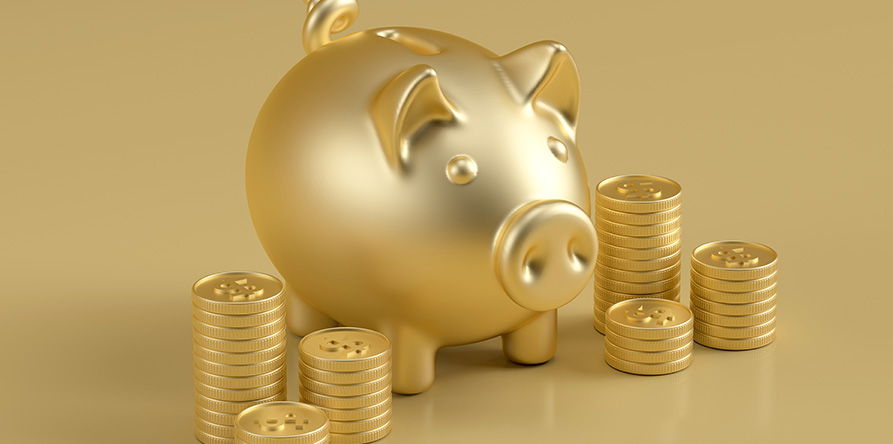
Build strong financial foundations to guarantee no future debt problems
In order to design, build, and live the life you desire, you need financial security and stability as a foundation. As a matter of fact, building a financial plan is similar to building a house. To hold up your needs throughout your lifetime, they both require a strong foundation.
So, going back to comparing a low-income but financially healthy individual to a six-figure person squandering their money. You could build a structural sound home designed to withstand the elements. Even though it might not be the biggest or more luxurious home in the neighborhood, its foundation is much stronger and more durable than the McMansion comprised of cheap materials.
Overall, having a solid financial foundation provides a sense of financial freedom. How? Because it can help you stop living paycheck to paycheck and eliminate debt. From there, you begin accumulating wealth so that you can actually achieve your goals, like being able to quit your dead-end job or retire comfortably.
While this may sound daunting, building a solid financial foundation can be broken down into smaller building blocks. Doing so makes this process more manageable.
Moreover, establishing a solid financial foundation requires time. It’s also important to build a financial foundation that provides for you now while ensuring you can achieve your future goals. That requires being thoughtful and responsible with your daily spending habits.
With all that being said, here’s how you can your foundations in personal finance.
Get to know your current spending habits.
To begin with, you need to understand your current financial situation. Examine your bank account and credit card statements to see what purchases you’ve made in the past few months. Next, group them into the following three buckets;
50% goes to needs.
This includes bills, groceries, transportation, housing, minimum debt payments, work clothes, and other necessities.
30% on discretionary expenses.
Expenses for entertainment, clothing, dining out, and personal care should not exceed 30 percent of your income each month. Depending on your situation, you might decide to cut these expenses first if you spend more than you earn.
20% goes to “Future You.”
Investing, saving, and paying off debt over and above the minimums are included in this category.
You should also add voluntary withholdings to your list based on your recent pay stubs. Also, insurance premiums are needs, while any RRSP contributions you make go in the “Future You” bucket. The rest of your withholdings are at your discretion. For example, you might withhold your public transit benefit, and you might also cancel your gym membership.
Finally, add up all the numbers. What is your monthly spending on each bucket? It doesn’t matter what the answer is, so don’t beat yourself up. This exercise isn’t supposed to make you feel bad. Instead, it’s designed to provide you with some perspective on your finances.
Also, you don’t have to follow the approximately named 50/30/20 to a tee. In fact, there are several other variations, such as 60/20/20, 70/20/10, or 80/20 you can try. The jest here is that you need to compare your income with your expenses so that you can budget accordingly.
Identify and plug spending leaks.
Continuing with the last point, compare how much you spend with how much you earn. Why is this important?
The first reason is if you spend more than you earn, you can start looking for ways to correct the situation. Maybe you might temporarily need to limit your spending to just the essentials. It may also mean making more conscious decisions like skipping your daily latte in favor of homebrew or reducing your ATM usage.
Alternatively, you might want to consider ways to supplement your income. Some suggestions would be asking for a raise, searching for a better-paying job, or picking up a side hustle.
Second, you’ll know exactly how much leftover you have at the end of each month once you’re spending less than you earn. These are the funds you’ll use to complete the building blocks.
As for now, you’ve pretty much-accomplished everything you need to do to create a written budget. Maintaining a monthly budget is a surefire way to make sure that your money is being used as you intend.
Save and stash any “extra” money.
Are you expecting a tax refund or salary increase? Set that money aside. And, whenever you get a raise, don’t go overboard with your spending. Put the extra money in your savings account.
The same holds true when you pay off a debt. As an example, suppose you paid $50 a month on a credit card and it’s finally paid off. Take that $50 and deposit it in a savings account.
Accessibility.
Emergency situations are something you can’t anticipate, so you want to have access to your money, but it shouldn’t be too easy to access. You should open a new account specifically to handle emergency situations. Simply designating money in your checking account can tempt you to take money out of it impulsively.
Safety.
Make it a point to safeguard your money. A stock market investment, with all its ups and downs, does not provide any guarantee that the money will be there when needed. Keeping it somewhere stable, where it has no depreciation risk, is the best choice.
Profitability.
It’s important that your money doesn’t sit idle. The cost of living expenses for three to six months can add up to a substantial amount of money. Avoid the “under-the-mattress” strategy and instead invest in an account that offers a good rate of return.
By looking at these three items, traditional bank savings accounts are not a good match. While they’re accessible and safe, you won’t earn anything on your deposits. You might be better off storing your cash with an alternative, like a money market account that yields high-interest rates.
Also, establish recurring transfers from your paycheck to special savings accounts to make saving easier.
Eliminate debts that drag down your financial health.
Credit card debt is a type of “bad debt”, since it does not allow you to build assets. Rather, it is just money you must repay with interest.
“Getting rid of any debt with no corresponding asset is essential to financial success because it naturally increases your net worth and frees you up from cumbersome payments,” notes Katie Brewer, CFP® and founder of financial coaching service Your Richest Life.
Get organized.
List all the debts you need to pay off in one location. The source of the debt, the amount owed, and the interest rate should be noted.
Pick a payment plan.
Making debt freedom a reality may require you to make some changes to your lifestyle and budget. “You can either prioritize [debt repayment] by interest rate and pay off the ones with the highest interest rate first, or prioritize it by smallest balance to largest balance and pay off the smallest balance first to get the momentum going,” Brewer says.
Take a break from your credit cards.
Taking a break from your credit cards could be a good idea if you find it difficult to pay off credit card balances. Brewer recommends setting aside cash in an envelope or using a debit card.
Get your feet wet with investing.
Over time, you can build wealth by investing in the stock market. Investing over the course of decades is by no means a get-rich-quick scheme, but it can create a valuable portfolio if done consistently.
Make sure you create your own investment strategy and investment policy statement before you invest in the market. The long-term goals in your strategy should drive your policy statement, which serves as a guide during market upheavals. There is a good chance that your stock market portfolio will fluctuate, so you need to be prepared for those peaks and valleys. When the market is volatile, avoid panic selling to avoid some possible disasters. Do not sell until your policy statement permits you to do so; stick to your investment plan.
Protect your assets and income.
The most valuable resource you possess is your earning potential. In your twenties and thirties, disability and death might be the last things on your mind. However, it’s during those times that you should take the most precautions to ensure you will not lose your lifetime earnings to your family.
As such, take the following steps to ensure these policies are in place for you.
- Disability insurance. Over your working years, you are three and a half times more likely of getting injured or become disabled due to illness than of dying. In the event of an accident or becoming unable to work, disability insurance can help make sure you can maintain your standard of living.
- Life insurance. When you die prematurely, your survivors are protected by life insurance. In addition to a death benefit, permanent life insurance policies accumulate cash value over time. Eventually, you could access that money for an unexpected house repair or college expenses. You can also use the cash value in retirement if you no longer need the full death benefit.
- Property/casualty insurance. The property/casualty insurance protects you in case you cause an accident that results in injury or damage to another person or their property. It will also protect you if someone without insurance or inadequate insurance injures you.
- Estate plan. Creating or updating an estate plan, which is a document that outlines how your possessions will be handled after you die. Among the features of an estate plan are naming your heirs, dividing up your assets, creating a trust, and assigning guardians to minor children.
- Balance your portfolio. As you diversify your portfolio, the less risky it becomes; if any one type of asset proves to be underperforming, there will be plenty of other assets to compensate for it.
Frequently Asked Questions About Personal Finance Foundations
1. What is personal finance?
Personal finance is all about managing your short- and long-term financial affairs. In addition to the products and services that are designed to help individuals manage their finances, the term also refers to an entire industry.
2. Why is personal finance important?
You cannot manage your financial needs on a day-to-day basis without a personal finance plan. When you have a good grasp of personal finance, you will have a better chance of investing and planning for retirement in the long run.
If you understand personal finance, you are better prepared to create a plan for improving your finances. Having this understanding will help you budget based on current needs while planning for the future.
3. Is your emergency fund sufficient?
Keep three to six months’ worth of living expenses in your emergency fund, as recommended by experts. Emergency funds will vary depending on factors such as;
- Your lifestyle
- Your area’s cost of living
- The income you earn and the security of your job over time
- Job opportunities in your field
- Affordability of your health insurance
For example, if your monthly living expenses are roughly $4000, your emergency fund should consist of $12,000 to $24,000.
4. What’s your net worth?
The cash surplus (or deficit) you have in your bank account each month serves as a measure of what direction your financial health is heading in the short term. Your net worth offers a broader view of your financial standing.
If you have student loans, credit card balances, or other such debt, keep track of your RRSP balance, home equity, and assets and reduce them accordingly.
5. Are you ever done saving?
Simply put, no.
Periodic expenditures such as routine vehicle and home maintenance, vacations, and special occasion gifts should be covered by your savings account.
Also, you should have regular savings to cover acute emergencies, such as paying off a credit card debt or replacing your car’s tires. You can’t always predict when these things will occur, so you should still plan for them because they won’t be true emergencies.
This article was written by Due from ReadWrite and was legally licensed through the Industry Dive Content Marketplace. Please direct all licensing questions to legal@industrydive.com.


